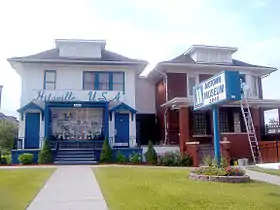Motown (music style)
Motown, or the Motown sound, is a style of rhythm and blues music[2] named after the record company Motown in Detroit, where teams of songwriters and musicians produced material for girl groups, boy bands, and solo singers during the 1960s and early 1970s. The music of Motown helped a small record company become the largest Black American-owned enterprise in the country and a national music industry competitor in the United States.[3]
| Motown | |
|---|---|
 Motown in 2006 | |
| Stylistic origins | |
| Cultural origins | c. 1964,[3] Detroit |
| Typical instruments | |
| Derivative forms | |
| Other topics | |
Overview
The sound, a sophisticated strain of R&B and pop, is known for its polished songwriting with "candid" vocal delivery.[2] Musicians involved in the production of a Motown track constituted a mix of eclectic musical backgrounds, such as jazz[7] and rhythm and blues.[3] It had a crossover[4] appeal it was called "clean R&B that sounded as white as it did black."[7] Productions featured a strong rhythm, layered instrumental sound, and memorable hooks,[8] utilizing large bands, strings, and organs.[3] Motown producers adhered to the "KISS principle" (keep it simple, stupid).[9]
Principal architects of the style were the songwriting trio Holland–Dozier–Holland and record producer Berry Gordy.[4] Their series of hits produced for solo singers as well as groups dominated the American and British charts in the late 1960s and exerted an influence on music in the United Kingdom.[5] Some of the components of the music, such as the "gospel break"[10] and four-on-the-top beat (inverted), survived in disco later in the 1970s.[11]
Smokey Robinson describes the style following way:
People would listen to it, and they'd say, 'Aha, they use more bass. Or they use more drums.' Bullshit. When we were first successful with it, people were coming from Germany, France, Italy, Mobile, Alabama. From New York, Chicago, California. From everywhere. Just to record in Detroit. They figured it was in the air, that if they came to Detroit and recorded on the freeway, they'd get the Motown sound. Listen, the Motown sound to me is not an audible sound. It's spiritual, and it comes from the people that make it happen. What other people didn't realize is that we just had one studio there, but we recorded in Chicago, Nashville, New York, L.A.—almost every big city. And we still got the sound.[12]
Notes and references
- "Motown" Overview. RhythmOne. Retrieved 2020-09-16.
- Hughes, Zondra "Are Whites Stealing Rhythm & Blues?" Ebony Magazine, Vol. 55, Johnson Publishing Company, p. 72, ISSN 0012-9011.
- Bjorn L, Gallert J (2001). Before Motown: A History of Jazz in Detroit 1920-60, University of Michigan Press, p. 199, ISBN 0-472-06765-6.
- Connell J, Gibson C (2003). Sound Tracks: Popular Music, Identity and Place, Routledge, ISBN 9780415170277.
- Newton, Tony (2011). Gold Thunder: A Legendary Adventures of a Motown Bassman, Quantum Media Publishing, p. 120.
- Nowell, David (2012). "Selected Pages". The Story of Northern Soul: A Definitive History of the Dance Scene that Refuses to Die. Pavilion Books. ISBN 9781907554728.
- Posner, Gerald (2002). Motown: Music, Money, Sex, and Power, Random House, p. 37, ISBN 0-375-50062-6.
- Campbell, Michael (2005). Popular music in America: the beat goes on. Wadsworth/Thomson Learning. ISBN 0-534-55534-9.
- Williams, Otis & Patricia Romanowski, Temptations (Lanham, MD: Cooper Square, 1988; updated 2002), p. 157, ISBN 0-8154-1218-5.
- Musical technique of "emptying the track of most instrumentation then gradually build[ing] it back up" (Echols 2020)
- Echols, Alice (2020-01-29). Hot Stuff: Disco and the Remaking of American Culture. ISBN 9780393077018.
- irshey, Gerri (1994 [1984]). Nowhere to Run: The Story of Soul Music, Da Capo Press, p. 187, ISBN 0-306-80581-2.